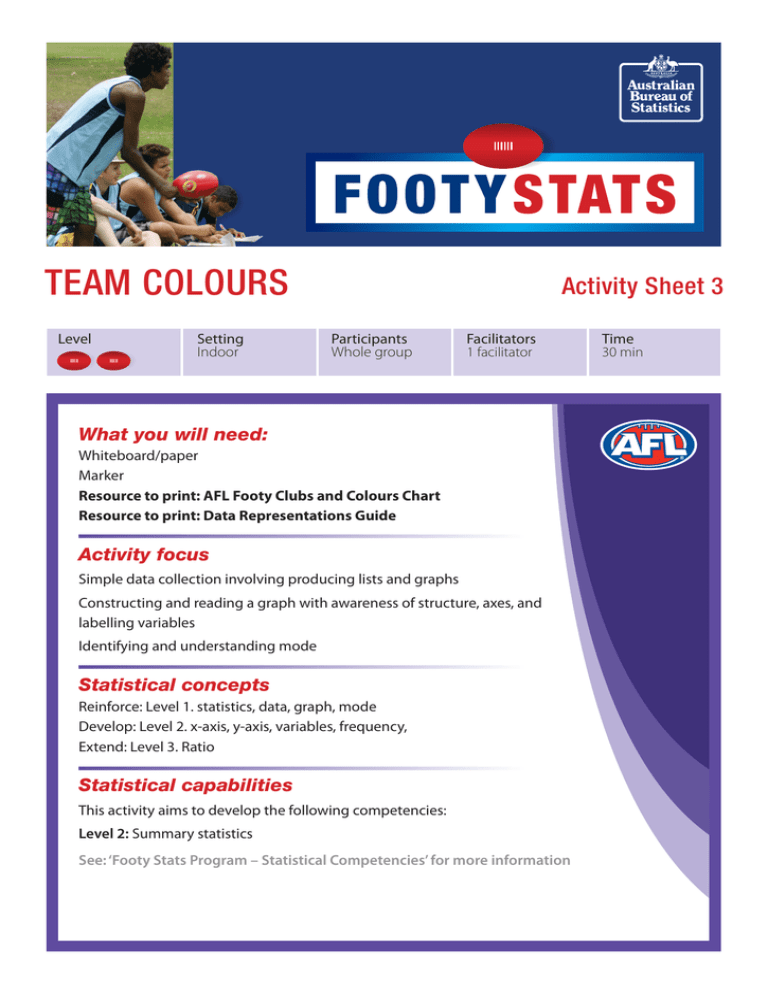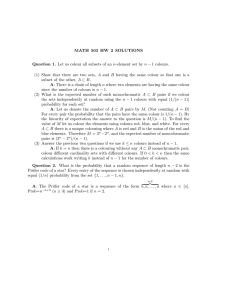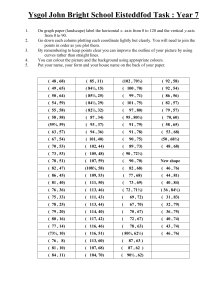TEAM COLOURS Activity Sheet 3 What you will need: Activity focus
advertisement

TEAM COLOURS Activity Sheet 3 Level Setting ParticipantsFacilitators Time Indoor Whole group 1 facilitator 30 min What you will need: Whiteboard/paper Marker Resource to print: AFL Footy Clubs and Colours Chart Resource to print: Data Representations Guide Activity focus Simple data collection involving producing lists and graphs Constructing and reading a graph with awareness of structure, axes, and labelling variables Identifying and understanding mode Statistical concepts Reinforce: Level 1. statistics, data, graph, mode Develop: Level 2. x-axis, y-axis, variables, frequency, Extend: Level 3. Ratio Statistical capabilities This activity aims to develop the following competencies: Level 2: Summary statistics See: ‘Footy Stats Program – Statistical Competencies’ for more information Activity Sheet 3 Learning Activities and Experience Time Introduction Body As a whole group, make a list on the whiteboard of all AFL teams and their team colours Create a tally for each colour and discuss how often different colours are used by football teams: • Which colour is used most (the mode) by AFL teams? 10 min (Facilitator to refer to AFL Footy Clubs and Colours Chart if needed) As a whole group, discuss the use of a graph to organise collected data Ask the group to help label the graph: • What are the two variables (‘colours’ & ‘number of teams’) we need to show on the axes in the graph? • What are the colours we need on our x-axis (horizontal line)? • Write all possible colours on the x-axis (e.g. white, navy, black) • How many teams are in the AFL? (this is the number our graph will have to go up to on the y-axis (vertical line) • Write the total number of teams on y-axis (e.g. 1, 2, 3… 18) 15 min As a group, use your team colours tally to create a column graph: • One by one, identify the colours of each team using your tally • For each colour, draw a column on the graph in line with the x- and y-axes (e.g. the first mark for the colour black will be above ‘black’ on the x-axis and next to the number ‘1’ on the y-axis) • Tick off each team in your list as you go Conclusion Encourage the participants to talk about the graph. Choose a colour from the AFL team colours and ask the participants: • How many teams use the chosen colour? • Which colour is used most often, known as the mode in statistics? • Which colour is used least? 5 min Activity Sheet 3 Why this is important The ABS Footy Stats program provides a fun and interactive introduction to the world of statistics. The program enables children to participate in a range of footy activities and learn how to collect, analyse, interpret and communicate basic statistical concepts. In this activity, participants: • Begin to develop an understanding of data and its uses in statistics • Begin to develop and use statistical terms/concepts • Work together to conduct a simple investigation: - Collating and organising data – creating a list and graph - Building a graph – constructing and naming x- and y- axis using different variables - Interpreting the information to answer simple investigation questions • Explore and identify the statistical concept mode within the data to answer investigation questions What you do Evaluate the statistical learning of the participants: • Are responses given by participants indicating their conceptual understanding? • Are participants appropriately using key statistical terms when describing the data? • Are participants correctly using the graph axes to position each data item? • Are participants able to answer the investigation questions in reference to the graph? Use other statistical concepts to learn more from the data, such as the ratio to compare team colours. For example, how many teams use the colour white as opposed to teams without white? Answer: 11 teams with white colour and 7 without white, which is shown as 11:7. FOOTY&STATS Ratio: MAKE A GREAT TEAM! Explore statistical concepts further with this activity






